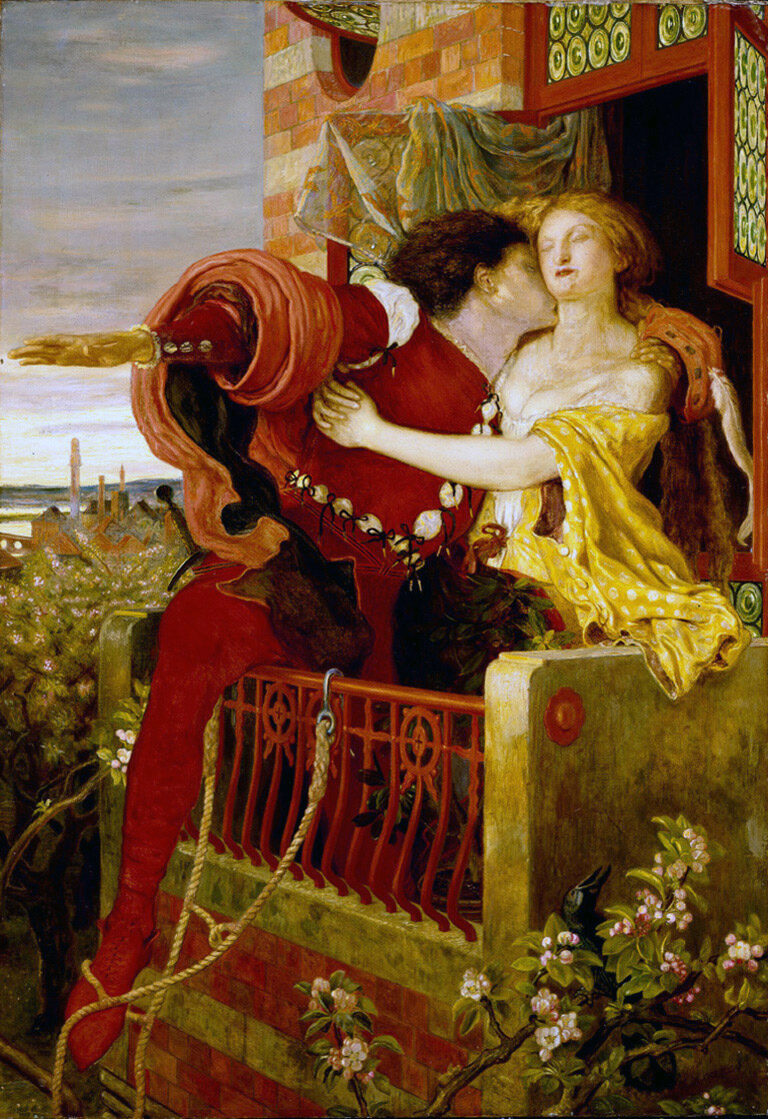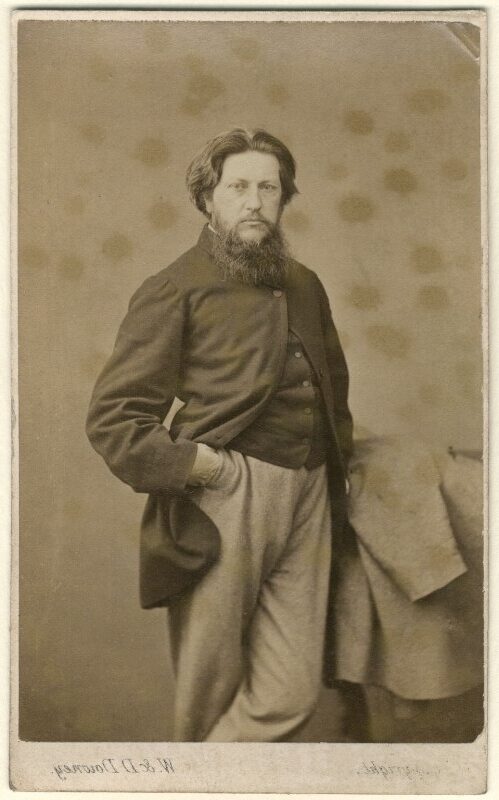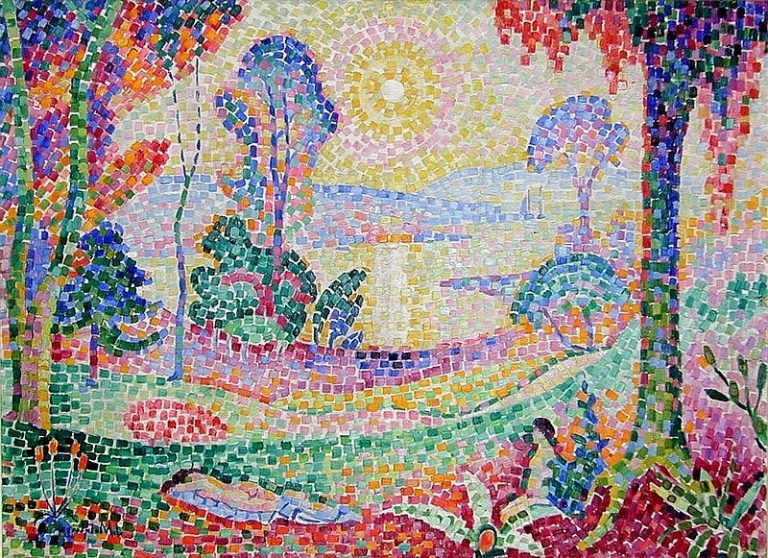Ford Madox Brown: Painter of Pre-Raphaelite Influence and Social Realism
Born: 16 April 1821, Calais, France
Death: 6 October 1893, London, England
Art Movement: Pre-Raphaelite
Nationality: British
Teachers: Albert Gregorius, Pieter van Hanselaere, and Gustaf Wappers
Ford Madox Brown: Painter of Pre-Raphaelite Influence and Social Realism
Life and Career of Ford Madox Brown
Ford Madox Brown lived a remarkable life spanning much of the 19th century. His artistic journey took him across Europe before establishing himself as a significant figure in British art, despite never officially joining the Pre-Raphaelite Brotherhood.
Early Years and Education
Ford Madox Brown was born on April 16, 1821, in Calais, France, to British parents. His father was a retired ship’s purser, which allowed the family to travel extensively throughout Europe during Brown’s youth.
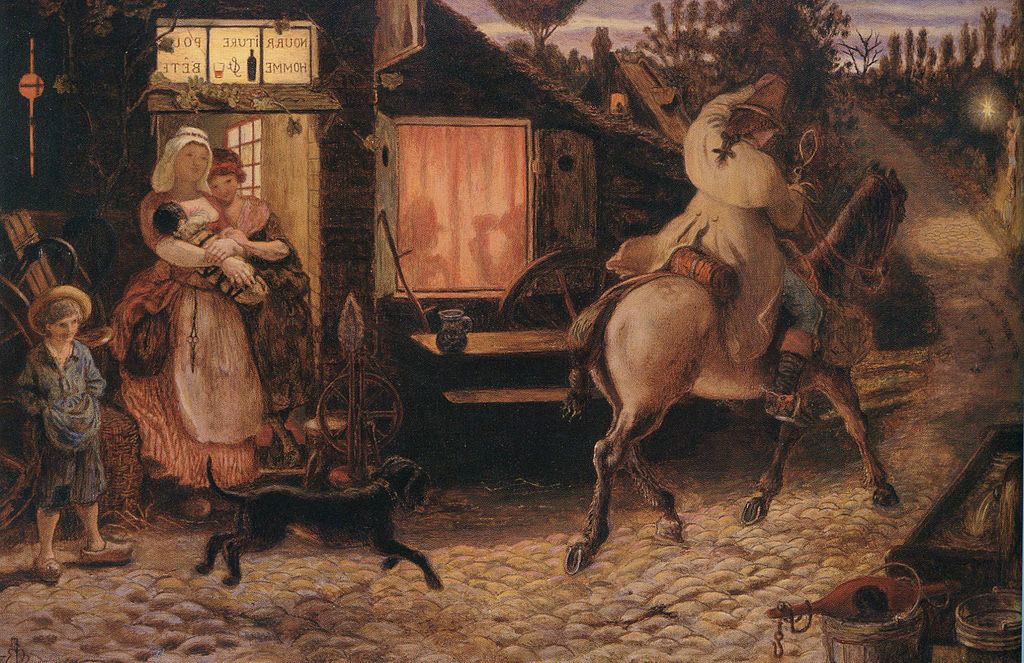
Traveller, 1868, by Ford Madox Brown
This exposure to different cultures and artistic traditions shaped his early development.
Brown’s formal artistic training began in Belgium, where he studied under Baron Gustaf Wappers in Antwerp. This education provided him with strong technical foundations in painting.
Later, he traveled to Paris to further develop his skills.
During his early career, Brown also spent time in Rome, where he encountered the Nazarenes, a group of German Romantic painters. Their emphasis on religious themes and revival of medieval artistic approaches influenced his developing style.
Pre-Raphaelite Association and Influence
Though never an official member of the Pre-Raphaelite Brotherhood, Brown became closely associated with the movement and its ideals. His relationship with the group began when Dante Gabriel Rossetti asked to study under him in 1848.
Brown’s work shared many characteristics with Pre-Raphaelite art: bright colors, attention to detail, and moral subjects. However, he maintained his own distinct style, often focusing on modern life subjects that differed from the medieval themes popular with other Pre-Raphaelites.
His painting “Work” (1852-1865) exemplifies his approach to social realism. Inspired by Thomas Carlyle’s writings on the dignity of labor, this complex composition depicts various social classes engaged in work in Victorian Britain, revealing Brown’s interest in contemporary social issues.
Later Years and Legacy
In the later part of his career, Brown undertook one of his most significant projects: twelve murals for Manchester Town Hall depicting the city’s history. This massive undertaking occupied him from 1879 until near the end of his life.
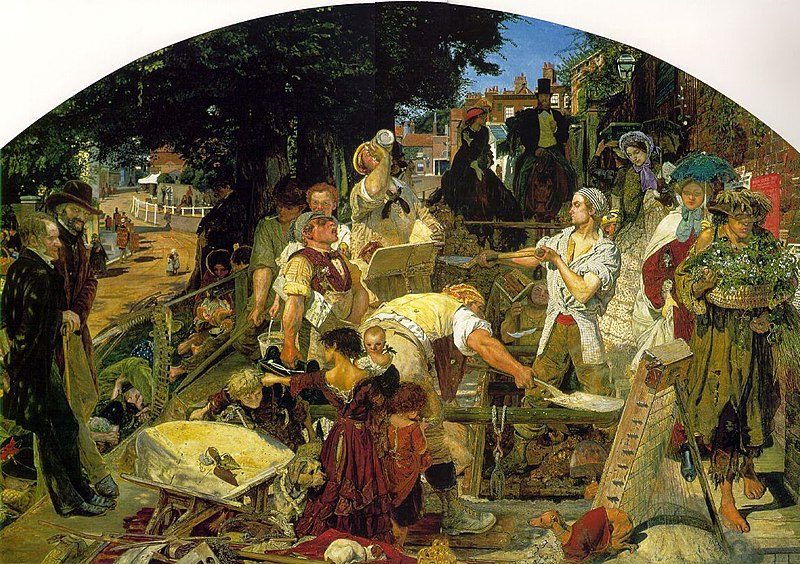
Work, 1852–1865, by Ford Madox Brown
Brown also became involved with the Arts and Crafts Movement, contributing designs for furniture and stained glass. This work demonstrated his versatility as an artist and his belief in unifying different artistic disciplines.
He died on October 6, 1893, in London. Though sometimes overshadowed by his Pre-Raphaelite contemporaries, Brown left a lasting legacy as an innovative painter who bridged Romantic and modern sensibilities. His distinctive approach to historical and contemporary subjects influenced generations of British artists.
Artistic Style and Techniques
Ford Madox Brown developed a distinctive artistic approach that combined vibrant colors, intense realism, and moral undertones. His technical skills spanned various mediums, allowing him to create works with remarkable detail and emotional depth.
Stylistic Development
Brown’s artistic style evolved significantly throughout his career. Initially influenced by continental historical painting during his time in Paris (1840-1843), his early works featured somber colors and dramatic elements suited to Byronic subjects.

Crabtree Watching the Transit of Venus in 1639, 1881–1888, by Ford Madox Brown
After encountering the Pre-Raphaelite Brotherhood in England, Brown adopted their emphasis on brilliant color and precise detail, though he was never formally a member of the group. His work began to display the hallmark Pre-Raphaelite attention to naturalistic detail and vivid coloration.
Unlike many contemporaries, Brown maintained a commitment to modern subjects alongside historical themes. His approach combined Renaissance-inspired compositions with unflinching realism, creating a distinctive style that stood apart from Victorian academic conventions.
Oil Painting and Watercolour
Brown demonstrated exceptional skill in both oil painting and watercolor techniques. His oil paintings feature remarkably luminous colors achieved through careful layering of paint on white grounds, a technique inspired by Pre-Raphaelite methods.
He often painted en plein air (outdoors) to achieve authentic lighting effects, sometimes working in challenging conditions to capture natural light accurately. This commitment to realism is evident in works like “Work” (1852-1865), where the sunlight feels tangibly bright.
In watercolors, Brown employed a meticulous approach, building up transparent washes to create depth and richness. His watercolor studies often served as preliminary works for larger oil paintings but stand as accomplished pieces in their own right.
Drawing and Draftsmanship
Brown’s drawing skills formed the foundation of his artistic practice. His preliminary sketches reveal a masterful understanding of human anatomy and perspective, with precise linework that captured both form and character.

Finding of Don Juan by Haidee, 1873, by Ford Madox Brown
He produced detailed cartoons (full-scale preparatory drawings) for his major compositions, working out complex arrangements before beginning the painting process. These drawings demonstrate his rigorous approach to composition and spatial relationships.
Brown’s draftsmanship is particularly evident in his figurative work, where he balanced idealization with truthful observation. His portrait drawings capture psychological insight through careful attention to facial expression and posture, reflecting his interest in conveying moral and emotional truths through his art.
Notable Works and Exhibitions
Ford Madox Brown created several important paintings that showcased his talent and social awareness. His works often depicted contemporary life and social issues, setting him apart from many of his contemporaries.
The Last of England
“The Last of England” (1855) stands as one of Brown’s most recognized masterpieces. The painting portrays a couple emigrating from England, inspired by the departure of Brown’s friend, the sculptor Thomas Woolner, who left for Australia.


The emotional power comes from the intense expressions on the subjects’ faces as they gaze at the White Cliffs of Dover fading in the distance. Brown painted himself and his wife Emma as the central figures, adding personal significance to the work.
The painting captures the 1840s-1850s emigration wave when many Britons sought new opportunities abroad. Today, the original is housed in the Birmingham Museum & Art Gallery, with another version in the Fitzwilliam Museum. It has become an iconic image of Victorian emigration.
Pretty Baa-Lambs
“Pretty Baa-Lambs” (1851-1859) represents Brown’s experimentation with outdoor painting techniques. Unlike many contemporaries who painted landscapes in studios, Brown worked en plein air for this pastoral scene.

Pretty Baa-Lambs, 1851-1859, by Ford Madox Brown
The painting shows his wife Emma and daughter Catherine in a field with lambs. Its honest depiction of natural light made it revolutionary for its time. Brown painted directly from nature, capturing genuine sunlight effects rather than studio approximations.
The work showcases Brown’s technical innovation and willingness to break from artistic conventions. The painting’s bright colors and natural setting offer a glimpse into Victorian family life while demonstrating Brown’s evolving artistic approach.
Portraiture and Commemorative Pieces
Brown’s portraiture skills allowed him to create memorable images of friends and family. His attention to detail and psychological insight made his portraits particularly compelling.
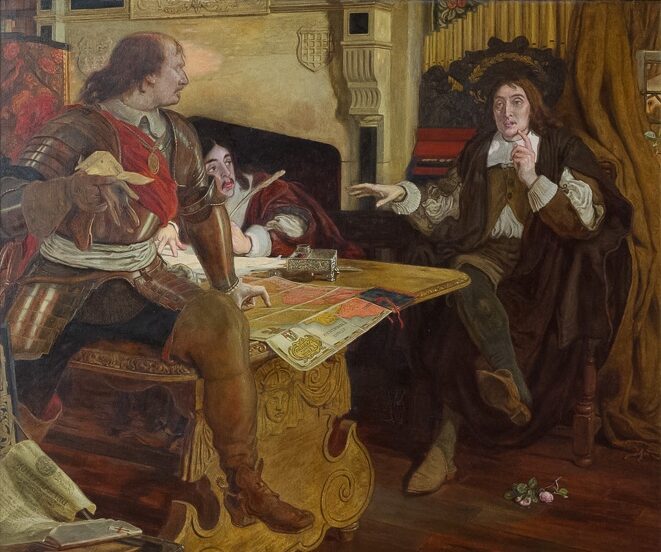
Cromwell, Protector of the Vaudois, 1877, by Ford Madox Brown
Among his notable portrait works are those of his patrons and fellow artists. Brown painted with remarkable sensitivity, capturing not just physical appearances but also personalities and emotional states.
His commemorative pieces often included symbolic elements that added layers of meaning. Many of these works can be found in major collections worldwide, including several in the Tate Britain. The Peter Nahum collection has featured some of Brown’s portrait studies.
Brown’s meticulous approach to portraiture established him as a skilled observer of human character, complementing his larger narrative paintings.
Frequently Asked Questions
Ford Madox Brown’s artistic career spanned many decades and left a lasting impact on British art. His unique approach to painting and his relationship with the Pre-Raphaelites continue to intrigue art historians and enthusiasts alike.
What are the most significant works of Ford Madox Brown?
“Work” (1852-1865) stands as Brown’s masterpiece, depicting laborers digging up a road while representing various social classes. This painting captures Victorian social commentary through detailed realism.
“The Last of England” (1855) portrays a couple emigrating from England, based on Brown’s own experience contemplating emigration to India. The circular composition and emotional intensity make it particularly striking.
“Christ Washing Peter’s Feet” (1852-1856) demonstrates Brown’s skill at religious subjects with its vibrant colors and psychological depth. His mural series for Manchester Town Hall also represents a significant achievement in public art.
How did Ford Madox Brown impact the Pre-Raphaelite movement?
Though never an official member of the Pre-Raphaelite Brotherhood, Brown significantly influenced the movement’s development. He served as a mentor to younger artists including Dante Gabriel Rossetti.
Brown’s commitment to vibrant colors and realistic detail aligned with Pre-Raphaelite principles. His work predated the official formation of the Brotherhood but shared their rejection of academic conventions.
His emphasis on moral subjects and historical accuracy helped shape the Pre-Raphaelite aesthetic. Brown’s independent position allowed him to incorporate their ideals while maintaining his distinctive approach.
Can you elaborate on Ford Madox Brown’s painting techniques and styles?
Brown employed meticulous attention to detail and rich, vibrant colors that characterized Pre-Raphaelite work. He often painted directly from nature to achieve truthful representation.
His compositions featured flattened space and elaborate symbolism. Brown rejected traditional methods of creating depth through atmospheric perspective, instead emphasizing linear clarity.
He developed a distinctive graphic quality in his paintings with strong outlines and textural precision. Brown’s work evolved from early historical paintings to more contemporary social scenes while maintaining his commitment to realism.
What was the relationship between Ford Madox Brown and other artists of his time?
Brown maintained close relationships with Pre-Raphaelite artists, particularly Dante Gabriel Rossetti whom he mentored. Their artistic exchange influenced both men’s development.
He collaborated with William Morris in the decorative arts movement, contributing designs for Morris’s firm. This partnership extended Brown’s influence beyond painting into applied arts.
Despite these connections, Brown maintained an independent position throughout his career. His somewhat outsider status allowed him creative freedom while still participating in important artistic circles of Victorian England.
How did Ford Madox Brown’s personal life influence his artwork?
Brown’s family frequently appeared as models in his paintings. His second wife Emma Hill posed for numerous works, including “The Last of England,” bringing emotional intimacy to his art.
The death of his first wife Elisabeth Bromley and later his son Oliver deeply affected him. These personal tragedies influenced the emotional depth and sometimes melancholic quality of his work.
His financial struggles throughout his career led him to teach and take on commercial work. These experiences arguably enhanced his understanding of different social classes, evident in paintings like “Work.”
What are some key themes and subjects in Ford Madox Brown’s paintings?
Social commentary appears prominently in Brown’s work. For example, in “Work,” he examines Victorian class structure. He portrayed labor with dignity at a time when such subjects were uncommon in fine art.
Historical and literary subjects feature in paintings like “Cordelia’s Portion” and “Romeo and Juliet.” Brown approached these traditional themes with psychological insight and historical accuracy.
Emigration and social displacement emerged as significant themes in “The Last of England.” His work often explored both personal and broader societal transitions. This was during a period of rapid change in Victorian Britain.


